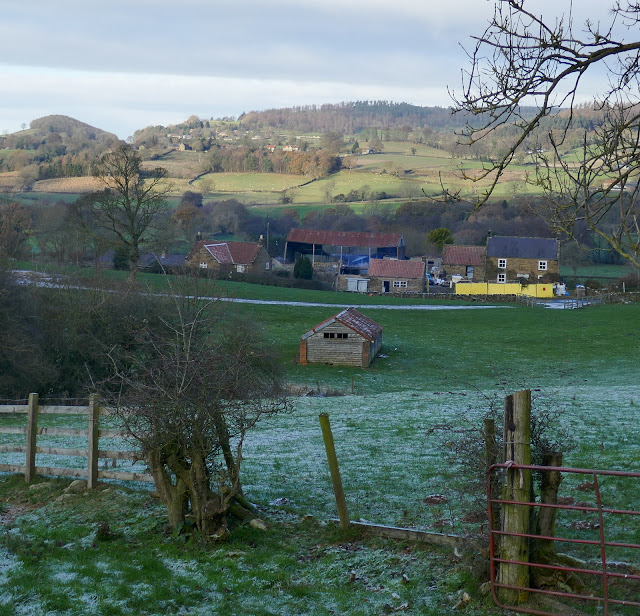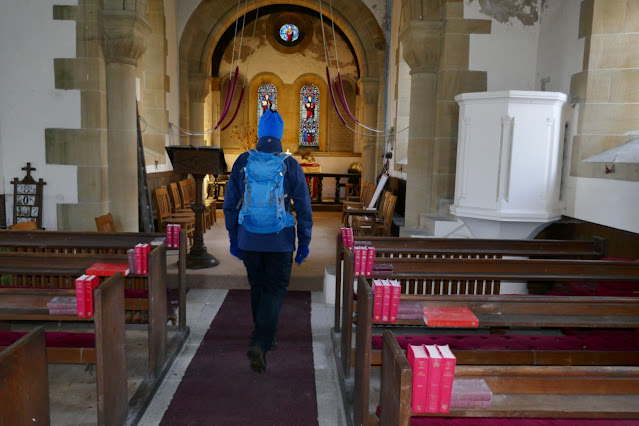Kepwick and Cowesby from Over Silton
5.5 miles Fine but very cold
A very cold day persuaded us to take a shorter walk today and one that we seem to undertake every year at about this time.
We parked at Over Silton at the roadside opposite the Old School House, having approached the village from the A19.
 |
| Today's walk from The Walker's Guide to the Hambleton Hills |
 |
| We parked opposite the Old School House |
 |
| ..and near to the Manor House |
 |
| Wombwell coat of arms on the Manor House |
Tom Scott Burns notes that the name Silton probably derives from Sal as in Upsal, which means Hall, and Ton, which is old Anglian for place or town.
We followed the road out of Over Silton passing the Manor House, which TSB tells us was once owned by the gallant gentleman Sir George Orby Wombwell, baronet, who served with the 17th Lancers and took part in the charge of the Light Brigade at Balaclava on 25th October 1854. His horse was shot from under him and he was taken prisoner but escaped on a Russian horse to rejoin his brigade and charge again, without sword or pistol! He died in 1913 aged 81.
We soon turned into a field at a gate. Although easy to miss, there is a way-mark on the gate here, but we found that with much of today's route although clearly shown on the map, where the track cuts across fields it is difficult to see.
 |
| Leave the road at this gate |
 |
| .. and follow the track to cross Penny Beck |
We walked through fields and crossed Penny Beck, soon reaching Greystone Farm. We passed by the attractive and tidily kept buildings to see a small open barn full of rosettes and prize certificates for the farm's Suffolk sheep.
 |
| Arriving at Greystone Farm |
 |
| Tidy Greystone Farm |
 |
| Prizes earned by the Silton Flock |
 |
| We continue past the farm |
 |
| Members of the Silton Flock of prize Suffolk sheep |
The route continues along field paths until reaching Nether Silton where we crossed the road near to the village green and rejoined our path which led us to Hall Farm.
 |
16th Century Silton Hall, modernised in 1838
|
 |
| Enormous Lime Tree dominates Nether Silton green |
 |
| Weather vane at Nether Silton |
 |
| Nether Silton |
 |
| Leaving the road to Nether Silton |
 |
| ... to walk past Hall Farm |
We continued beyond the farm to walk through fields frozen as hard as iron until reaching the footbridge over Sorrow Beck.
After crossing the beck we walked through fields to reach a stone footbridge that is built over what used to be a 3.5 mile narrow gauge railway. Constructed in 1833 this railway brought limestone mined near Kepwick to kilns near to the Yarm and Thirsk turnpike road.
 |
| A spring ensures the path is always wet here |
 |
| Crossing Sorrow Beck |
 |
| Joining a green lane |
 |
| ... which we follow |
 |
| ... to reach the old railway bridge |
We crossed another field and joined Peasland Lane which we followed for a mile into Cowesby.
The first building one comes to on entering Cowesby is St Michael and All Angels Church. As we approached we were disappointed
that the weather vane, fallen on our last visit, had not been replaced. We were pleased to find the door was unlocked and we spent a few moments exploring the old building.
We sat on the Jubilee bench at the side of the church to enjoy coffee and scones before wandering up Cowesby High Street.
 |
| It looked better on the tower |
 |
| Looks like a good spot for coffee |
 |
| Our view from the Jubilee Bench |
 |
| Houses in Cowesby High Street |
 |
| Cowesby High Street |
We followed the tarmac through Cowesby and past Home Farm, then turned left onto the western shoulder of Pen Hill. This path then leads gently down towards Kepwick.
 |
| Clive approaches the obelisk on Howe Hill |
The obelisk was erected in the memory of John Henry Boyer Warner who erected Kepwick Hall and constructed two reservoirs upon the moors above, to service the estate and village.
We reached Kepwick village and looked at the privately owned chapel which unfortunately is locked to the public but has an interesting history. Originally this building was a mission room but was rebuilt as a chapel by the Warner family of Kepwick Hall, whose only son was shot down during WWI whilst serving with the RFC against Baron Richthofen's flying circus.
Interestingly Warner's late sister formed the basis of one of James Herriot's characters, Mrs Pumphries, who owned the pekingese Tricky Woo.
 |
| Kepwick Chapel |
We left Kepwick at a footpath sign to re-enter fields which took us first to the disused railway and then to Bridge Beck which we crossed on a new bridge. A hundred yards later we reached and crossed Sorrow Beck. The side of the bridge had been broken off, we wondered how, and was lying in the stream below.
 |
| Crossing the Kepwick to Borrowby road |
 |
| .. and following field tracks |
 |
| Crossing the disused narrow-gauge railway |
 |
| Crossing Bridge Beck |
 |
| Crossing Sorrow Beck.. what happened here? |
 |
| We hope no-one leaned too heavily on the bridge and took the plunge! |
In pathless fields way-marks are few and far between, but keep straight ahead to the outskirts of Nether Silton and the old Manor Stone which is in the middle of a field next to the 16th century manor house which still remains. The stone is cryptically inscribed with letters whose meaning I've set out below the photograph. This inscription was the idea of a Squire Hicks to mark the spot where the medieval manor house once stood.
It's become something of a ritual that Clive takes my photo at this spot, showing how the passage of time erodes both the Manor Stone and myself.
 |
| Clive shy's at the jump |
 |
| Ram and ewes, Manor House behind |
 |
| "You come here often?" |
 |
| The Old Manor Stone |
 |
| Two monoliths |
 |
Here The Grand Old Manor House Stood The Black Beams Were Oak, The Great Walls Were Good The Walls At The East Wing Are Hidden Here A Thatched Cottage Like A Barn Was Erected
Year AD 1765 A Wide Porch Spans A Yard And Alcove |
|
 |
| The Old Manor House |
A few steps took us to the church of All Saints and we popped inside for a look around. All Saints is a chapel of ease which was rebuilt in 1812. Such a chapel is built for the convenience of parishioners who would find it difficult to access the main church, in this case isolated St Mary's which we would pass by shortly.
 |
| All Saints Church, Nether Silton |
 |
| Clive reads the Roll of Honour |
 |
| Altar window |
 |
| Tom Grainger, we saw his name on the Roll of Honour |
Tom Scott Burns explains that wood used in the altar rails and other refurbishments was presented by a R M Jaques, and were from HMS Dreadnought of Lord Nelson's day.
We left the church and immediately turned off the road at a white gate opposite, just near to the post box, leading to a narrow passage that passes between houses to open fields.
 |
| Silton House |
 |
| Through the passageway |
 |
| ... and across the fields to Over Silton |
 |
| St Mary's, Over Silton and snow coming |
 |
| The end of the walk at Over Silton |
Once in the fields we were now returning to Over Silton and walking parallel to Greystone Farm and its Suffolk sheep.
After crossing the tarmac of Kirk Ings Lane we passed St Mary's Church, which appears abandoned in the middle of a field, though still in use, before walking to Over Silton and the end of our walk.
A short drive took us to Osmotherley where we popped into the Three Tuns to discuss today's short winter walk.
 |
| "To short walks and long drinks!" |














































































No comments:
Post a Comment